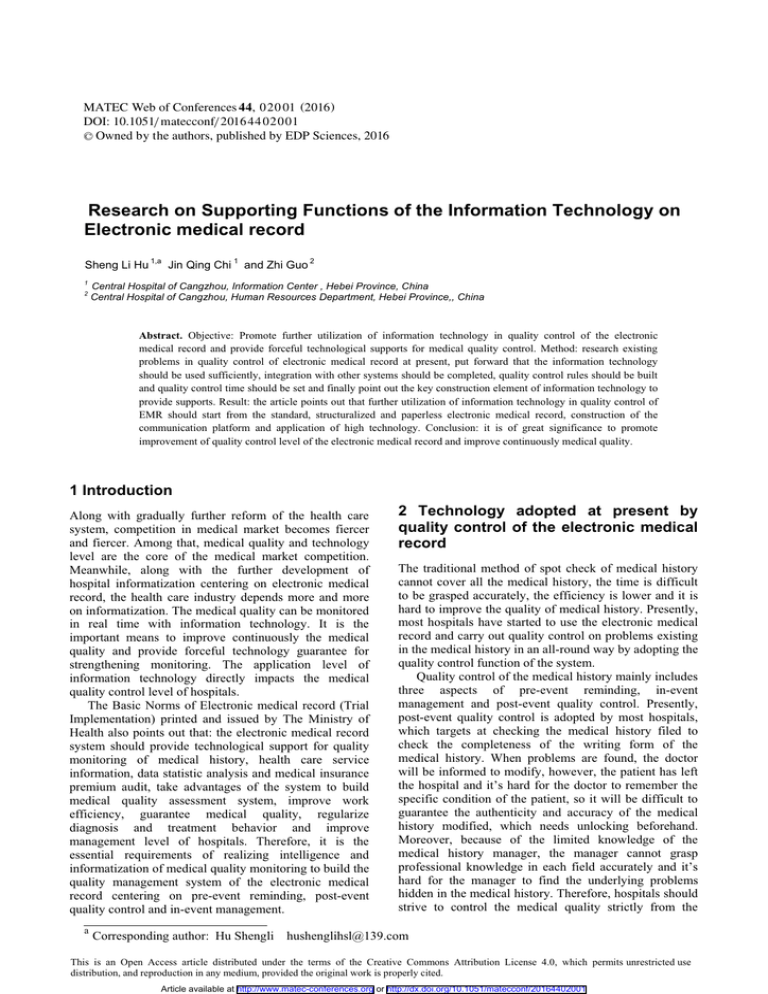Research on Supporting Functions of the Information Technology on
advertisement

MATEC Web of Conferences 4 4, 0 2 0 01 (2016 ) DOI: 10.1051/ m atecconf/ 2016 4 4 0 2 0 01 C Owned by the authors, published by EDP Sciences, 2016 Research on Supporting Functions of the Information Technology on Electronic medical record Sheng Li Hu 1,a Jin Qing Chi 1 and Zhi Guo 2 1 2 Central Hospital of Cangzhou, Information Center , Hebei Province, China Central Hospital of Cangzhou, Human Resources Department, Hebei Province,, China Abstract. Objective: Promote further utilization of information technology in quality control of the electronic medical record and provide forceful technological supports for medical quality control. Method: research existing problems in quality control of electronic medical record at present, put forward that the information technology should be used sufficiently, integration with other systems should be completed, quality control rules should be built and quality control time should be set and finally point out the key construction element of information technology to provide supports. Result: the article points out that further utilization of information technology in quality control of EMR should start from the standard, structuralized and paperless electronic medical record, construction of the communication platform and application of high technology. Conclusion: it is of great significance to promote improvement of quality control level of the electronic medical record and improve continuously medical quality. 1 Introduction Along with gradually further reform of the health care system, competition in medical market becomes fiercer and fiercer. Among that, medical quality and technology level are the core of the medical market competition. Meanwhile, along with the further development of hospital informatization centering on electronic medical record, the health care industry depends more and more on informatization. The medical quality can be monitored in real time with information technology. It is the important means to improve continuously the medical quality and provide forceful technology guarantee for strengthening monitoring. The application level of information technology directly impacts the medical quality control level of hospitals. The Basic Norms of Electronic medical record (Trial Implementation) printed and issued by The Ministry of Health also points out that: the electronic medical record system should provide technological support for quality monitoring of medical history, health care service information, data statistic analysis and medical insurance premium audit, take advantages of the system to build medical quality assessment system, improve work efficiency, guarantee medical quality, regularize diagnosis and treatment behavior and improve management level of hospitals. Therefore, it is the essential requirements of realizing intelligence and informatization of medical quality monitoring to build the quality management system of the electronic medical record centering on pre-event reminding, post-event quality control and in-event management. a 2 Technology adopted at present by quality control of the electronic medical record The traditional method of spot check of medical history cannot cover all the medical history, the time is difficult to be grasped accurately, the efficiency is lower and it is hard to improve the quality of medical history. Presently, most hospitals have started to use the electronic medical record and carry out quality control on problems existing in the medical history in an all-round way by adopting the quality control function of the system. Quality control of the medical history mainly includes three aspects of pre-event reminding, in-event management and post-event quality control. Presently, post-event quality control is adopted by most hospitals, which targets at checking the medical history filed to check the completeness of the writing form of the medical history. When problems are found, the doctor will be informed to modify, however, the patient has left the hospital and it’s hard for the doctor to remember the specific condition of the patient, so it will be difficult to guarantee the authenticity and accuracy of the medical history modified, which needs unlocking beforehand. Moreover, because of the limited knowledge of the medical history manager, the manager cannot grasp professional knowledge in each field accurately and it’s hard for the manager to find the underlying problems hidden in the medical history. Therefore, hospitals should strive to control the medical quality strictly from the Corresponding author: Hu Shengli hushenglihsl@139.com This is an Open Access article distributed under the terms of the Creative Commons Attribution License 4.0, which permits XQUHVWULFWHGXVH distribution, and reproduction in any medium, provided the original work is properly cited. Article available at http://www.matec-conferences.org or http://dx.doi.org/10.1051/matecconf/20164402001 MATEC Web of Conferences source, change the mode centering on post-event quality control, control the quality of the medical history strictly, find problems, remind the doctor timely, solve problems timely, replace the post-event management with preevent control and guarantee to accomplish the medical history timely with certain quality. 3 Issues should be paid attention to in construction of the electronic medical record quality control system 3.1. Integration of the electronic medical record with other systems The electronic medical record system should be integrated with the HIS, PACS, LIS, ECG and operative anesthesia system seamlessly to realize interaction and share of information and avoid occurrence of information isolated island. For example, the hospital can acquire the critical value situation of K, Ca, Na and Cr via the interface with LIS so that the patient can be treated timely in the critical time and saved to a maximum extent. Some hospitals have built data interaction platform and acquire data needed from all sorts of systems [1-3]. This kind of transmission via interchange of XML has great superiority. However, this XML language can only provide syntax norms and cannot realize standardization of syntactic structure and semantics. The use of HIL7 CDA can well realize semantic description of clinical documents of electronic medical record. It can be seen from the present situation that information systems in most hospitals lack unified and normative interface standard, don’t conform to the HL7 standard basically and the standard is not unified, which impact the medical quality control of hospitals and bring difficulties for the development of regional medical informatization. 3.2 Construction of quality control rules. In the quality control system, the hospital should build quality control points, build various quality control rules and carry out intelligent judgment on quality control rules. Taking the time-bound control of medical history writing for an example, time-bound control is an important means to improve the medical history quality. The electronic medical record can record the creator, the creation time and component names of the template automatically backstage, save all modification trace in the past and mark accurate modification time and information of the person who modifies the medical history. The times are all read-only and the medical workers cannot modify the time. Even though the doctor records an earlier time in the medical history, the quality control is subjected to the backstage record so that the accuracy of quality control can be guaranteed. In addition, the quality control system will check the completeness of the template contents, for example, the resident admission record should include the history of the present illness and the history of the past illness. In the main complaints, there must be the position, symptom and time of duration. The check is subjected to successful save in the data base, so the doctor should develop the habit of saving the template timely. To acquire relevant information in the electronic medical record via the quality control rules, such as node elements of the position and the symptom in the complaint, the whole structure of these node elements must be disposed. The system will carry out statistic analysis on the standard and structural extracted elements in the value range to provide forceful data support for scientific research and management of medical science. 3.3 Confirmation of the quality control time. After the confirmation of quality control rules, the following important work is to confirm the quality control time. Taking the confirmation of the time for quality control with time limit for an example, the resident admission record should be accomplished within 24 hours after the patient is admitted to the hospital, which needs to accurately confirm the beginning and stop time of quality control. In the information system of hospitals, there are three choices of hospital admission time, namely the time when the doctor fills in the electronic hospital admission receipt in the outpatient service department, the time when the patient handles hospital admission procedures in the HIS hospital admission office and the time when the doctor gives the first doctor’s advice in the resident physician department. Under this situation, it should be taken into consideration that it needs some time for the patient to arrive at the ward to receive treatment of the doctor. Therefore, it is more appropriate to take the time when the doctor gives the first doctor’s advice as the hospital admission time. For quality control with time limit of the medical history, if problem happens, the doctor will be reminded in the form of message and SMS. If the time is forced to be controlled, it will definitely bring unnecessary burden for the doctor. Therefore, it is also an important issue to strengthen communication among the quality control section, medical history room and medical workers. 3.4 Sufficient use of information technology. In the information system of hospitals centering on the electronic medical record, the information technology should be used sufficiently, for example, the doctor can identify the stupid mistake such as that a male has a menstrual history by virtue of the automatic grading function in the system. To avoid similar medical history and guarantee the quality, technology means should be used to restrict the copy and paste functions, including shortcut keys of CTRL+C and CTRL+V. Same information of one patient can be copied; the copied contents should be checked and information of different patients should not be copied. Outer contents should not be copied to the electronic system and personalized modes should not be introduced. It must be realized that the information technology is not omnipotent. Hospitals should complete the management system; formulate 02001-p.2 ICEICE 2016 corresponding rewards and punishment measures depending on the problems existing in the quality control system to improve the enthusiasm of medical workers in writing the medical history. Hospitals should carry out pre-event monitoring to the greatest extent via informationized means, for example, the surgery grading management can be carried out for doctors and corresponding rights and limits can be set up as per the professional title and the operational qualification of doctors. Hospitals can set up the usage rights of antibiotics in the system as per the qualification and training situation of doctor to make doctors operate within the rights and limits, reduce medical risks and guarantee medical quality. The electronic medical record quality control system should collect system data in real time and operations such as saving, modification and deleting of data base should be carried out in real time when the doctor writing a medical history. Therefore, it has a high requirement for the server performance, the quality control server should be set up alone and it is more appropriate to choose a high-grade server. 4 The information technology provides key supporting construction elements for quality control of electronic medical record 4.1. Standardization and structuring electronic medical record system. of The Standardization and structuring of electronic medical record data are critical to realize quality control of electronic medical record. It can be seen from the construction situation of electronic medical record in China that unified data standard has not realized truly. Although many manufacturers claim that their own system is standardized and structured electronic medical record, few of electronic medical record can conform to the Basic Architecture and Data Standard of Electronic medical record, Basic Template Data Set Standard of Electronic medical record Clinic Document, Data Array and Data Element of Electronic medical record Clinic Document and other information data standards or adopt HL7 message standard and CDA [4]. The Implementation Rules for Review Standards of Three-level General Hospitals (2011 Version) of the Ministry of Health explicitly regulates that clinic document presentation should be standardized and CDA is supported. Data standards of electronic medical record include four contents: the data structure of electronic medical record, clinic document information template of electronic medical record, data array and data element standard of clinic documents of electronic medical record and basic template and data set standard of clinic documents of electronic medical record. International and domestic standards with generally mature application should be adopted to practice to the greatest extent. Taking the international classification of diseases code ICD10 for an example, the birth place should not be a text to make doctors input arbitrarily, and a standard national code table of provinces and cities should be provided for the medical workers to conduct standard choice. For the quality control of medical history, the structural data entry problem should be solved and the structural medical history editor should be adopted to solve the structural data collection problem of medical history writing [5-8]. To guarantee the accuracy of the data collection source, the value range of date elements should also be standardized so that required value range information can be abstracted from the data elements. Presently, the medical history quality control system in some hospitals can abstract relevant structural elements, but these structural elements cannot completely conform to the standard of the Ministry of Health. Along with the continuous improvement of knowledge of the medical science and each social field, the value range of data elements should be updated synchronously to adapt to the continuous improvement of the society. Along with the coming of the big data times, to efficiently take advantage of the massive amounts of clinic data information, standardized and structural electronic medical record should be realized objectively to exert the use value of medical record to a maximum extent and provide important data supports for clinic scientific research, teaching and management. The first page of the medical history is the essence, the accuracy and completeness of which must be guaranteed via information technology. Phenomena such as lacunas, omission and incomplete record should be controlled via the information technology and the key quality control points such as the main diagnosis, metastasis and progression, physician’s signature, conformity of diagnosis must be filled in. Verification should be carried out as per validation rules, for example, the time of leaving the hospital should not be earlier than the hospital admission time, the time of successful salvage should not be more than the time of salvage and if surgery information has been filled in, the surgery type should be filled in as well. 4.2. Paperless electronic medical record. To realize automatic and intelligent quality control of electronic medical record, the paperless electronic medical record must be realized firstly, because the quality control system cannot carry out efficient quality control on the paper medical history. Presently, most hospitals in China have adopted the electronic medical record system, but basically they filled in and print the electronic medical record, sign with hand and file the paper medical history in the medical history room, which is a condition that the paper medical history coexists with the electronic medical record and the true paperless electronic medical record has not been realized. If the system has a function defect or the medical workers print the medical history without timely saving the medical history, system data losses will be caused. Medical history quality control under this condition will definitely be impacted significantly. To realize the paperless electronic medical record, it is critical to apply the 02001-p.3 MATEC Web of Conferences electronic signature and the trusted time stamp, which can guarantee the legal enforcement of the electronic medical record and improve the accuracy of medical history quality control as well. Therefore, realization of paperless storage of electronic medical record and establishment of supporting management system are effective ways to improve the quality control level of electronic medical record. hidden danger of medical treatment, improvement of medical history quality, realization of refined management of hospitals, etc. However, the information technology is not omnipotent. People say that it depends on 30% technology and 70% management. Only they integrate closely can hospitals continuously improve the medical quality and promote continuous improvement of management level. 4.3. Construction platform . References of the communication QinǂZhizhong, LiǂMeihua, WangǂWei. Electron ApplicationǂofǂScreenshotǂinǂtheǂLinksǂQ ualityǂCotrolofǂElectronicǂMedicalǂRecords. Chinese Medical Record,7, (2015). 2. SHI Jun—feng, LI Qian—qian, BI Jian—xin. Electronic Medical Records Integrated Management Based on CIoud Computing. Chinese Hospital Management,35,2, (2015). 3. Li Shunfei, Tang Xiaodong, Liu Shunan etal. Design and application of medical record quality management system based on new electronic medical record. Chongqing Medicine,43,19, (2014). 4. Zhang Lei, TYe Zhou, Tuo Kuanqian et al. Development and Application of Intelligent Electronic Medical Record System with Quality and Safety as the Core. China Digital Medicine,9,5, (2014). 5. Chen Dapeng, Chen Jinxiong, Guo Zhixu. Quality Control System of New Type Electronic Medical Record. Hospital Administration Journal of Chinese People’s Liberation Army,20,7, (2013). 6. Xiao Qiang, Wu Weibin, Wang Shuyan et al. Research on the Input Method of Semi-structured Electronic Medical Records Based on XML, China Digital Medicine,,10,1, (2015). 7. Qiu Sheng. On the application of structured electronic medical records. Straits Science, 9, (2013). 8. Liu Peng. Research and System Improvement of Structured Electronic Medical Record Storage Retrieval Based on Hadoop. China Digital Medicine,10,20, (2015). 9. Zhu Guojun, Lang Liwei, Lu Weishi et al. Clinical Application of Mobile Nursing Quality Control Information System. China Digital Medicine,8,10, (2014). 10. Pu Xiaoying, Zhao Guangyu, Li Ailing et al. Construction of Informatization Platform to Improve Medical Quality Management. Chinese Health Quality Mangement,20,6, (2013). 11. WANG Wei-min, ZHANG Xue-yan. Problems in electronic medical records of Beijing hospitals and their solutions. Chinese Journal of Medical Library and Information Science,8, (2015). 12. Chen Li, Dai Ziqing, Rong Xia et al. Electronic Medical Record Archiving and Clinical Demands. Chinese Medical Record,8, (2015). 1. It is of significance to build the information communication platform among quality control managers and medical workers in the system to feed back the quality control result to the corresponding doctor timely, for example, the first time of course of disease should not be more than eight hours and the remaining time should be sent in the system to remind the doctor. If the doctor is only informed in the form of a message window, it will work only when the medical worker log in the electronic medical record and the form is monotonous, so the doctor is informed by the message while being informed in the form of a message window to remind the medical worker to finish the writing of the medical history. For special quality control, for example, the emergent consultation requires that the consultant should arrive at the site within ten minutes after the application of consultation is sent out. It is insufficient only with messages and news, so the telephone needs to be used to send the emergent notice. Construct the medical history quality control tracking system and trace each problem existing in quality control. If the doctor has written the medical history or modified some problem, the problem will be showed as having been solved in the tracking system. The outstanding problems should be marked with red, which can remind the medical worker again and provide effective evidence when impose implement penalty and punishment on the quality control personnel. 4.4. Application of high and new technology. Application of high and new technology such as the internet of Things, artificial intelligence and information mobile technology in electronic medical record can effectively improve the quality control level of the medical history, for example, the mobile workstation is used to effectively improve the nursing quality control [9]. The knowledge base provides important support for the writing of structural electronic medical record via artificial intelligent technology. In terms of construction of intelligent knowledge base, some hospitals have carried out useful exploration in knowledge collection and arrangement, knowledge creation and presentation and maintenance and application of knowledge base[1012]. 5 Conclusions Information technology plays an irreplaceable role in quality control of electronic medical record, decrease of 02001-p.4





